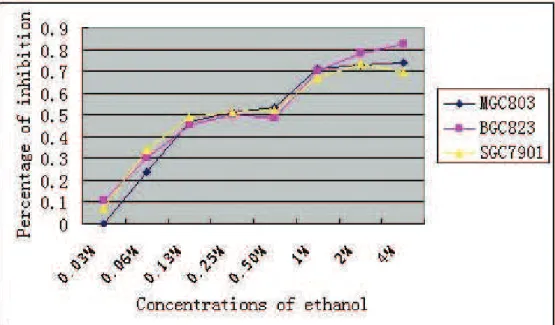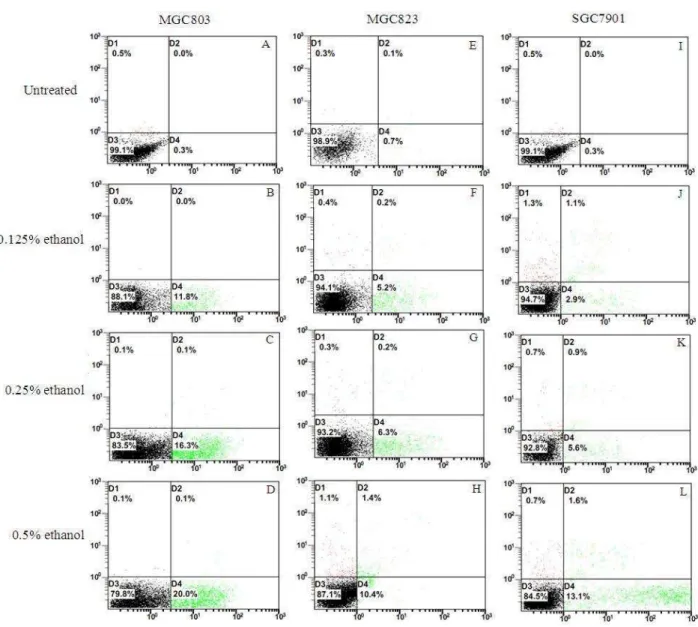493
THE EFFECT OF LOW CONCENTRATIONS OF ETHANOL ON GASTRIC ADENOCARCINOMA CELL LINES
LINGJIAO WU1, SHAOHUA CHEN2, YU ZHANG3,4 and HONGMING PAN3
1 State Key Laboratory for Diagnosis and Treatment of Infectious Diseases, he First Ailiated Hospital,
College of Medicine, Zhejiang University, Hangzhou 310003, China
2 Department of Gastroenterology, he First Ailiated Hospital, College of Medicine, Zhejiang University, Hangzhou 310003, China
3 Department of Oncology, Sir Run Run Shaw Hospital, College of Medicine, Zhejiang University, Hangzhou 310016, China
4 Department of Oncology, Zhejiang Hospital, Hangzhou 310012, China
Abstract - Chronic alcohol consumption was identiied as a signiicant risk factor for cancer in humans. he aim of the study was to analyze the inluence of low concentrations of ethanol on gastric adenocarcinoma cell viability, apoptosis, and changes in the expression of alcohol dehydrogenase with ethanol treatment. Gastric adenocarcinoma cell lines (MGC803, MGC823 and SGC7901) were treated with diferent concentrations of ethanol (0.03125%, 0.0625%, 0.125%, 0.25%, 0.5%, 1%, 2%, and 4%). he MTT (3-(4,5-dimethylthiazol-2-yl)-2,5-diphenyltetrazolium bromide) assay and low cytometry were used to analyze the efect of ethanol treatment on cell viability and apoptosis. Western blotting was used to analyze the expression of alcohol dehydrogenase in gastric carcinoma cells. Ethanol treatment inhibited cell proliferation in gastric adenocarcinoma cell lines in a signiicant dose-dependent manner. Ethanol induced apoptosis of gastric adenocarcinoma cells in a dose-dependent manner. he alcohol dehydrogenase activity of gastric adenocarcinoma cells increased with the increase in the concentration of ethanol. Ethanol inhibited cell viability and the growth of gastric adenocarcinoma cell lines. Low concentrations of ethanol also induced apoptosis and increased the expression of alcohol dehydrogenase of the gastric adenocarcinoma cell lines.
Key words:Ethanol, gastric adenocarcinoma, apoptosis, alcohol dehydrogenase
INTRODUCTION
Alcohol is the oldest and most widely used drug in the world. here are possible health beneits in the consumption of low levels of alcohol, while efects can be severely detrimental in cases of chronic alco-hol abuse. Heavy drinking over a long period of time can lead to alcoholic liver disease. Further, chronic alcohol consumption was identiied as a signiicant risk factor for cancer in humans. In one such study, alcohol consumption increased the risk of gastric
cancer in subjects with gastric atrophy (OR=2.4, p=0.03) (Yamaji et al., 2009) However, the exact mechanism of ethanol-associated carcinogenesis re-mains unknown (Jelski and Szmitkowski, 2008).
to be carcinogenic. Second, the enzyme ALDH then converts the acetaldehyde into non-toxic acetic acid (National Institute on Alcohol Abuse and Alcohol-ism, 2007). Ethanol is oxidized not only in the liver, but also in the gastrointestinal tract. Although this gastric ethanol metabolism is considerably less than that of the liver, this pathway has important relevance with respect to the irst stage (metabolism of ethanol by gastric ADH) of the metabolism of alcohol, and to ethanol-induced tissue toxicity (Seitz et al., 1994). he present study aimed to analyze the inluence of low concentrations of ethanol on cell viability, apop-tosis and the expression of ADH of gastric carcinoma cells.
MATERIALS AND METHODS
Cell culture
Human gastric adenocarcinoma cell lines (MGC803, MGC823, and SGC7901) were purchased from Zhejiang Cancer Hospital. Cells were cultured in RPMI1640 media supplemented with 10% fetal bo-vine serum (GIBCO, USA), 100 U/ml penicillin, and 100 U/ml streptomycin. Cells were then digested with 0.25% volume trypsin and 0.02% volume of EDTA. Logarithmic growth phase cells were chosen for the next step of the experiment ater conventional methods of passage.
Detection of the efect of ethanol on cell proliferation by MTT assay
Cells were seeded into 96-well plates at 1×104 cells (100ul)/well) and grown in an incubator in 5% CO2, at 37°C for 24 h. Ater this, the cells were treated with ethanol at diferent concentrations (0.03125%, 0.0625%, 0.125%, 0.25%, 0.5%, 1%, 2%, 4%).
Un-treated cells (without ethanol) were set as the control group. Ater culturing for 48 h, 20 ul MTT (0.5%) (Sigma, USA) was added, and the cells were incubat-ed for another 4 h at 37°C. 150 ul DMSO was added to each well ater removing the supernatant. Ater shaking, the samples were dissolved and put aside for 30 min. At this point, the blue-violet crystals were completely dissolved. he absorbance (A) of samples was measured at 490 nm using the Bio-Rad Model 680 Absorbance Microplate Reader. he inhibitory rate (IR) was calculated according to the following formula: IR (%) = (1-Experimental group A/Control group A) ×100%
Detection of apoptosis by low cytometry
MGC803, MGC823, and SGC7901 cells were incu-bated with or without diferent concentrations of ethanol (0.125%, 0.25%, 0.5%) for 48 h. Control and treated cells were stained using the Annexin V/pro-pidium iodide apoptosis kit, and the cells were ex-amined under a Cytomics FC500 MPL luorescence microscope (Beckman Coulter Company, USA). he distribution of cells and the percentage of dye-labeled cells was then determined
Expression of ADH by Western blotting
Each protein band was analyzed on the Bio-Rad Ver-sa Doc Image Analysis System.
RESULTS
Inhibitory rate of ethanol on gastric carcinoma cell proliferation
he anti-proliferative efect of ethanol (0.03125%, 0.0625%, 0.125%, 0.25%, 0.5%, 1%, 2%, 4%) on gas-tric adenocarcinoma cell lines (MGC803, MGC823, and SGC7901) was signiicant ater treating the cells with diferent concentrations of ethanol for 4 h (Fig. 1). Cell proliferation was inhibited by ethanol in a signiicant dose-dependent manner in all of the three gastric adenocarcinoma cell lines. he IC50 for all samples was between 0.63% and 1.25%, while the in-hibitory rates of ethanol (concentration~2.5%) were all above 70%.
Cell apoptosis of ethanol on gastric adenocarcinoma cells
Flow cytometry analysis revealed that ethanol could
induce cell apoptosis. Apoptosis induced by ethanol in MGC803, BGC-823, and SGC7901 cells increased in a dose-dependent manner with the increase of ethanol concentration (Table 1, Fig. 2).
Efect of ethanol on expression of ADH
he expression of ADH increased with the increase of alcohol concentration on the gastric adenocarci-noma cells (Fig. 3).
DISCUSSION
ent pathological conditions such as cancer.
hree kinds of gastric cancer cell lines, MGC803 and BGC823 (poorly diferentiated gastric adeno-carcinoma) and SGC7901 (moderately diferentiated gastric adenocarcinoma), were included in the study.
It was found that apoptosis induced by ethanol treat-ment increased with the increase in the concentra-tion of ethanol in all three cell lines. Our results were consistent with other studies that revealed the same results on the efect of ethanol on the other gastric cancer cell lines.
In humans, the enzyme alcohol dehydrogenase (ADH) is contained in the lining of the stomach and in the liver. he stomach is involved in the irst-pass metabolism of alcohol in humans. It does this by catalyzing the oxidation of ethanol to acetaldehyde, which allows for the consumption of alcoholic bev-erages. ADH activity varies between men and wom-en, between old and young, and among people and cultures from diferent areas of the world (Parlesak et al., 2002). Moreover, diferences can be found in the activities of total ADH, showing ADH was signii-cantly higher in cancer cells than in healthy mucosa (Jelski, 2007; Jelski et al., 2010). Until now, the efect of diferent concentrations of ethanol on the expres-sion of ADH of gastric mucosa has been unknown. In this study, ADH expression in three human gas-tric adenocarcinoma cell lines (MGC803, BGC823, SGC7901) induced by diferent concentrations of ethanol, was examined. ADH expression of gastric adenocarcinoma cell lines increased with the increase in the concentration of ethanol. his suggested that alcohol consumption could induce the expression of gastric ADH in all the three cell lines.
Alcohol consumption is extremely common in modern society. From this study, it was found that ethanol could induce apoptosis of gastric adeno-carcinoma cell lines and stimulate the expression of ADH. However, epidemiologic evidence for an association between alcohol consumption and the risk of developing gastric cancer remains
conlict-ing (Mahjub and Sadri, 2007; Shimazu et al., 2008). Further research should be performed, focusing on the relationship between alcohol and gastric cancer, and the mechanisms involving ethanol metabolism in gastric cancer.
Acknowledgments - his work was supported by a grant of the Program from the Department of Education of Zhejiang Province (No. 20061391).
REFERENCES
Jelski, W. and M. Szmitkowski (2008). Alcohol dehydrogenase
(ADH) and aldehyde dehydrogenase (ALDH) in the can-cer diseases. Clin Chim Acta. 395: 1-5.
Jelski, W. Chrostek, L., and M. Szmitkowski (2007). he activity of
class I, III, and IV of alcohol dehydrogenase isoenzymes and aldehyde dehydrogenase in gastric cancer. Dig Dis Sci. 52: 531-535.
Jelski, W., Orywal, K., Laniewska, M. et al. (2010). he diagnostic
value of alcohol dehydrogenase (ADH) isoenzymes and al-dehyde dehydrogenase (ALDH) measurement in the sera of gastric cancer patients. Clin Exp Med. 10(4):215-219
Kasagi, N. (1999). Ethanol Induces Apoptosis in Human
Gas-tric Carcinoma Cells: he Role of Apoptosis-Related Mol-ecules. Yonago Acta medica. 42: 113-124.
Mahjub, H., Sadri, G.H. (2007). Association between alcohol
consumption and gastric cancer: a meta-analysis. J Res Health Sci. 7: 63-72.
Shimazu, T., Tsuji, I., Inoue, M. et al. (2008). Alcohol drinking and gastric cancer risk: an evaluation based on a


